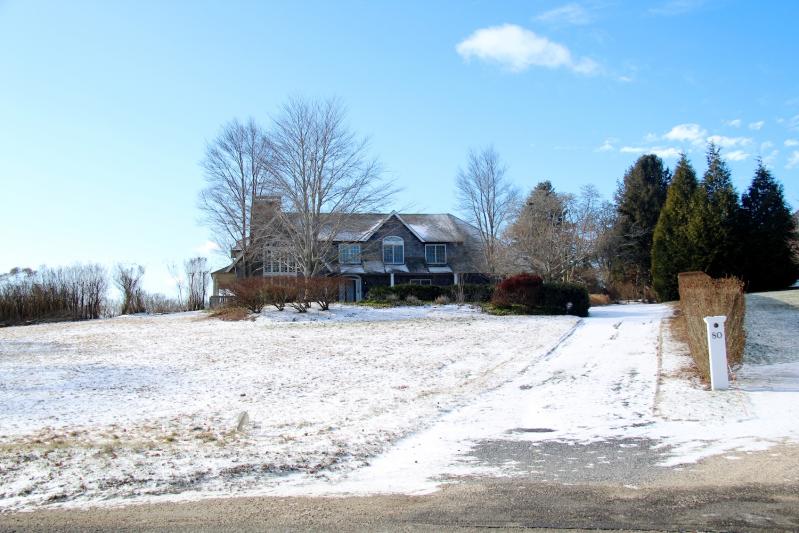They say the wheels of justice turn slowly, but if so, no one told County Supreme Court Justice Paul Hensley. Just days after 84 Wainscott Hollow Road L.L.C. submitted a lawsuit against the East Hampton Town Architectural Review Board seeking an annulment of the board’s Dec. 12 denial of its application, the judge granted the petition “in all respects.”
Over the course of four hearings, the limited liability company presented different versions of the application to the board. It will now be able to build the last version submitted, shared with the board in December.
“It was the fastest turnaround we’ve ever seen or heard about, even in a fairy tale,” said Alice Cooley, of Matthews, Kirst, Cooley & Choron, the East Hampton law firm that represented 84 Wainscott Hollow Road. “The judge adopted our arguments wholesale, and that’s a judge who has a history of denying Article 78s.” (An Article 78 is the name for an appeal of a determination made by a local government’s appointed board, filed with the State Supreme Court.)
“We’re still reviewing the decision and trying to decide if an appeal is in the cards,” said Rob Connelly, the East Hampton Town attorney. The town has 30 days from Jan. 22 to make a decision.
There was strong community opposition to the applicant’s plan to tear down the existing house and build an eight-bedroom, 10-bathroom 7,374-square-foot house with a 945-square-foot attached garage, tennis court, swimming pool, detached spa, and 480-square-foot open-air pavilion with kitchen and fireplace on just 1.39 acres of land. A Zillow posting of the property boasted that it would have 11,000 square feet of livable space.
The A.R.B. denied the application, citing town code, and said the mass and scale of the redevelopment was out of character and harmony with the neighborhood, specifically calling out its setback from the road and building configuration. Usually, residential applications don’t come before the A.R.B., but because 84 Wainscott Hollow Road borders an agricultural overlay district, it fell under the board’s purview.
The town code allows the board to consider “the relative visibility of the structure to the general public” and gives it authority to reject plans that are out of harmony “because of proposed style, scale, materials, mass, line, color, detail or placement upon the property.” It can deem it out of harmony if “the proposed location and design of structures and adjacent open areas or adjacent existing structures, whether on or off the lot or site in question,” clash.
“The A.R.B. standards are much more subjective than what you find in [zoning] area variances,” said Mr. Connelly. “Area variances standards are statutory, they come from state law. There are no statutory standards for the A.R.B., so it’s more open to interpretation. They’re not necessarily weaker, but it does open their determinations up to more challenges.”
“It’s always nice to win,” said Brian Matthews, another partner in the law firm representing 84 Wainscott Hollow. “The board ignored the fact that we were double the front yard setbacks and under coverage and clearing maximums. When you’re so far back and compliant, it becomes more of a personal preference for the board members. They start acting like they have the power to site buildings. The problem wasn’t the code. The problem was the board’s failure to recognize the limits of their jurisdiction. We were there because of proximity to agricultural land. This wasn’t having any impact on that land. That should have been the end of it. Instead, the board was talking about the color of the house.”
Chip Rae, the chairman of the A.R.B., offered no comment, citing ongoing litigation.
The decision sent a chill through those devoted to preserving the rural character of the Wainscott hamlet.
“The A.R.B.’s disapproval of this application comports with its purposes, among them to preserve the ‘enduring rural charm and historic character’ of East Hampton, increasingly being destroyed by insensitive development,” read a statement from the Wainscott Heritage Project.
“Wainscott Heritage Project recognizes this court decision as yet another blow to the town code and to the efforts of ordinary citizens to uphold and apply the law while serving on the Town of East Hampton’s appointed boards. Guided by our aim to preserve the historic character of Wainscott, which includes protecting familiar visual features of a neighborhood, we continue to request [that] the A.R.B. follow adopted procedure and hold public hearings for applications that have potential negative impacts in the agricultural overlay district. In the absence of public hearings, the review board is sure to receive letters on controversial developments and should ensure these public comments are read into the record.”
Seven letters in opposition to the project were received by the board ahead of its November meeting.
“The amount of money that is out there emboldens people to become more litigious and go to the courts to seek what they want, instead of working with the town as they used to in the past,” said Mr. Connelly.
They say the wheels of justice turn slowly, but if so, no one told County Supreme Court Justice Paul Hensley. Just days after 84 Wainscott Hollow Road L.L.C. submitted a lawsuit against the East Hampton Town Architectural Review Board seeking an annulment of the board’s Dec. 12 denial of its application, the judge granted the petition “in all respects.”
Over the course of four hearings, the limited liability company presented different versions of the application to the board. It will now be able to build the last version submitted, shared with the board in December.
“It was the fastest turnaround we’ve ever seen or heard about, even in a fairy tale,” said Alice Cooley, of Matthews, Kirst, Cooley & Choron, the East Hampton law firm that represented 84 Wainscott Hollow Road. “The judge adopted our arguments wholesale, and that’s a judge who has a history of denying Article 78s.” (An Article 78 is the name for an appeal of a determination made by a local government’s appointed board, filed with the State Supreme Court.)
“We’re still reviewing the decision and trying to decide if an appeal is in the cards,” said Rob Connelly, the East Hampton Town attorney. The town has 30 days from Jan. 22 to make a decision.
There was strong community opposition to the applicant’s plan to tear down the existing house and build an eight-bedroom, 10-bathroom 7,374-square-foot house with a 945-square-foot attached garage, tennis court, swimming pool, detached spa, and 480-square-foot open-air pavilion with kitchen and fireplace on just 1.39 acres of land. A Zillow posting of the property boasted that it would have 11,000 square feet of livable space.
The A.R.B. denied the application, citing town code, and said the mass and scale of the redevelopment was out of character and harmony with the neighborhood, specifically calling out its setback from the road and building configuration. Usually, residential applications don’t come before the A.R.B., but because 84 Wainscott Hollow Road borders an agricultural overlay district, it fell under the board’s purview.
The town code allows the board to consider “the relative visibility of the structure to the general public” and gives it authority to reject plans that are out of harmony “because of proposed style, scale, materials, mass, line, color, detail or placement upon the property.” It can deem it out of harmony if “the proposed location and design of structures and adjacent open areas or adjacent existing structures, whether on or off the lot or site in question,” clash.
“The A.R.B. standards are much more subjective than what you find in [zoning] area variances,” said Mr. Connelly. “Area variances standards are statutory, they come from state law. There are no statutory standards for the A.R.B., so it’s more open to interpretation. They’re not necessarily weaker, but it does open their determinations up to more challenges.”
“It’s always nice to win,” said Brian Matthews, another partner in the law firm representing 84 Wainscott Hollow. “The board ignored the fact that we were double the front yard setbacks and under coverage and clearing maximums. When you’re so far back and compliant, it becomes more of a personal preference for the board members. They start acting like they have the power to site buildings. The problem wasn’t the code. The problem was the board’s failure to recognize the limits of their jurisdiction. We were there because of proximity to agricultural land. This wasn’t having any impact on that land. That should have been the end of it. Instead, the board was talking about the color of the house.”
Chip Rae, the chairman of the A.R.B., offered no comment, citing ongoing litigation.
The decision sent a chill through those devoted to preserving the rural character of the Wainscott hamlet.
“The A.R.B.’s disapproval of this application comports with its purposes, among them to preserve the ‘enduring rural charm and historic character’ of East Hampton, increasingly being destroyed by insensitive development,” read a statement from the Wainscott Heritage Project.
“Wainscott Heritage Project recognizes this court decision as yet another blow to the town code and to the efforts of ordinary citizens to uphold and apply the law while serving on the Town of East Hampton’s appointed boards. Guided by our aim to preserve the historic character of Wainscott, which includes protecting familiar visual features of a neighborhood, we continue to request [that] the A.R.B. follow adopted procedure and hold public hearings for applications that have potential negative impacts in the agricultural overlay district. In the absence of public hearings, the review board is sure to receive letters on controversial developments and should ensure these public comments are read into the record.”
Seven letters in opposition to the project were received by the board ahead of its November meeting.
“The amount of money that is out there emboldens people to become more litigious and go to the courts to seek what they want, instead of working with the town as they used to in the past,” said Mr. Connelly.




